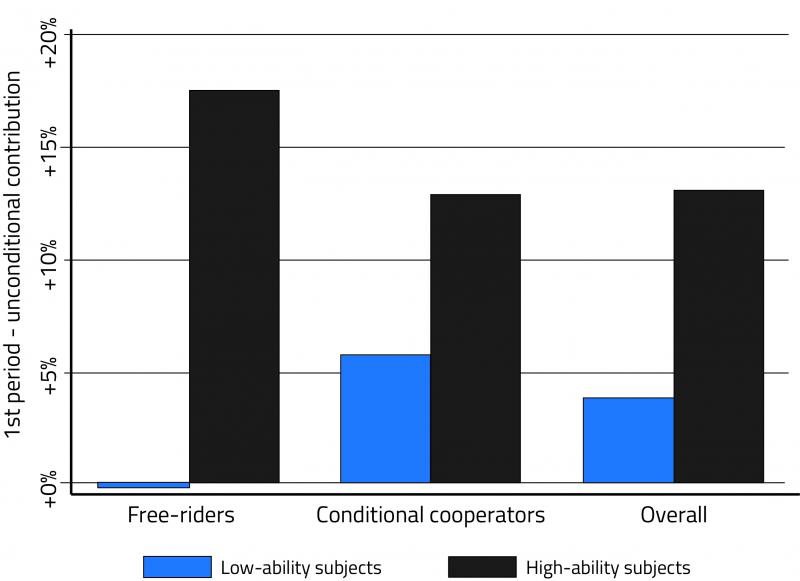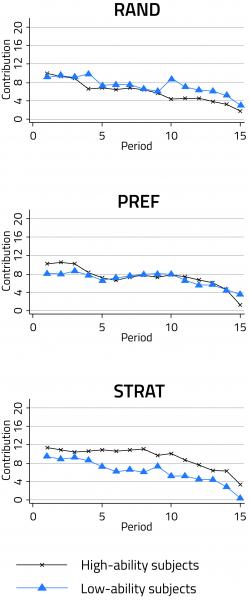Gilles Grandjean, Mathieu Lefebvre & Marco Mantovani, 2022, Journal of Economic Behavior and Organization, 195, 171-185
RESEARCH PROGRAM
In finitely repeated public goods games, each participant has to decide how much to contribute, out of a private endowment, to the production of a public good which is shared within the group. The private marginal return on the public good is below one and the social marginal return is above one such that the dominant strategy for each player is to contribute zero, while the social optimum is achieved if everybody contributes all of the endowment. However, highly replicable experimental evidence shows that contributions are initially high, and gradually decrease over time.
These findings are commonly attributed to the existence of heterogenous (non-standard) preferences. According to this “preference-based” explanation, these empirical patterns are due to interaction between conditional cooperators and free riders. Conditional cooperators are willing to contribute to the public good only if the other group members also contribute. Since free-riders do not contribute to the public good, contributions decrease over time because conditional cooperators reduce their contributions when they interact with free riders.
A second explanation is based on individual strategic motivations. According to this ‘strategy-based’ explanation, participants contribute larger amounts in the initial periods because of the likelihood that current contributions will sustain mutually beneficial future cooperation. These incentives are higher when the future is distant and vanish as the game approaches its end.
While the literature has typically focused on one of these two dimensions, preferences and strategic ability provide distinct intrinsic and extrinsic motives to contribute and shape individuals’ reaction to others’ contributions. Investigating potential complementarities between the two can yield insights into behavior in repeated public goods games.

Figure 1. Difference between repeated (firstperdiod) and one-shot game
PAPER’S CONTRIBUTIONS
In this paper, we study both preferences and strategic ability in a finitely repeated public goods game within the same experimental design. We categorize participants in the experiment as free-riders, unconditional cooperators, and conditional cooperators based on their choices in an unconditional one-shot public goods game. In addition, we determine their level of strategic ability by averaging their scores on a cognitive reflection test, a race game, and a beauty contest. We then manipulate group formation and study groups that are homogenous either in terms of preferences (treatment PREF) or in terms of strategic ability (treatment STRAT). A random group formation treatment (RAND) serves as a baseline. The participants are not informed of the group composition and our framework allows us to identify the effect of group composition, disentangling it from the effect that information about group composition may have through beliefs.
Overall, our results show that strategic ability is crucial to sustain cooperation even in a context where cooperation cannot be sustained under standard equilibrium notions. Comparing contributions in the first period of the repeated public goods game with those in the one-shot version used to classify participants (Figure 1), we find that high-ability subjects respond to repeated interaction by increasing their contributions more than low-ability ones, whatever their preferences. Also, placing high-ability subjects together boosts their contributions: Figure 2 shows that individuals of high ability respond positively to treatment STRAT by contributing more when matched with other high-ability individuals than when matched at random. Surprisingly, we do not find that conditional cooperators contribute more when placed in homogenous groups. However, we observe a positive interaction between preferences and strategic ability, with groups of high-ability conditional cooperators sustaining high levels of contributions until the final rounds. The data suggest that a shared inclination toward cooperation combined with the strategic ability to recognize and reap the benefits of enduring cooperation enable a group to sustain high levels of cooperation in finitely repeated public goods games.

Figure 2. Average contributions by strategic ability and treatment
FUTURE RESEARCH
While previous studies had highlighted the relevance of matching similar people to sustain cooperation in repeated interactions, our results show the importance of also taking into account forward-looking strategic thinking and anticipations of others’ choices. However, the question of which type of ability is key to sustaining cooperation in such games remains open. The evidence also points to a relevant interaction between preferences and ability. New experimental treatments where participants are matched according to both their preferences and their ability would be a welcome development to validate our finding.
→ This article was issued in AMSE Newletter, Summer 2022.
© VectorMine / Adobestock






